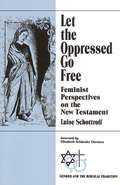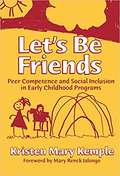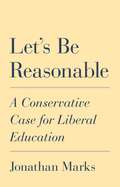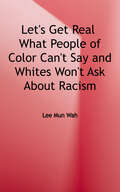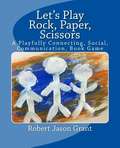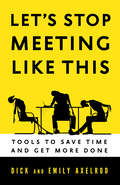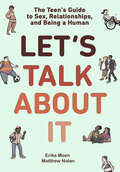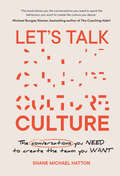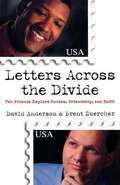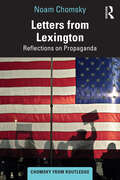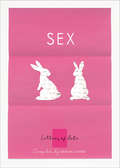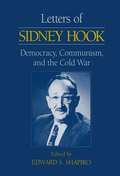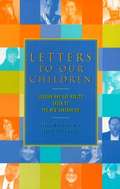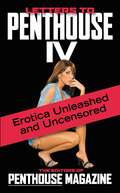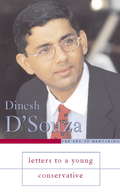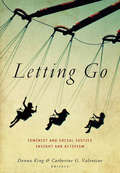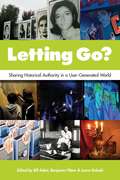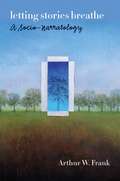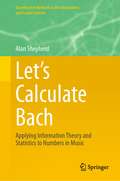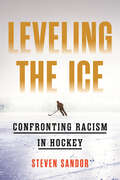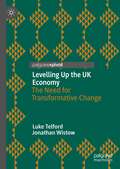- Table View
- List View
Let the Oppressed Go Free: Feminist Perspectives on the New Testament
by Luise Schottroff Annamarie S. KidderThis book draws together fascinating recent studies by a leading European scholar of aspects of the New Testament of special interest to women. These essays, translated for the first time, will deepen feminist scholarship in the English-speaking world.
Let's Be Friends: Peer Competence And Social Inclusion In Early Childhood Programs (Early Childhood Education)
by Leslie R. Williams Kristen Mary KempleThis book describes methods of support and intervention teachers can use to create social inclusion in preschool and the primary grades. Combining general early childhood education with special education, this unique volume explains a wide variety of strategies ranging from environmental arrangement, on-the-spot teaching, and cooperative learning, to more intensive, individually-targeted interventions for children experiencing particular challenges and disabilities. “This is a book richly populated with young children, their words, their concerns, and a host of collaborative strategies for promoting peer affirmation. . . . How I wish that all young children would have had the benefit of teachers who read, understood, and implemented the ideas in this book.” —From the Foreword by Mary Renck Jalongo, Editor-in-Chief, Early Childhood Education Journal “Let’s Be Friends addresses critical questions about how early childhood programs can help all young children, including those at-risk, to develop competent social interaction skills . . . an invaluable contribution in its translation of research results to practical interventions.” —Karen E. Diamond, Director, Child Development Laboratory School, Purdue University
Let's Be Reasonable: A Conservative Case for Liberal Education
by Jonathan MarksA conservative college professor's compelling defense of liberal educationNot so long ago, conservative intellectuals such as William F. Buckley Jr. believed universities were worth fighting for. Today, conservatives seem more inclined to burn them down. In Let's Be Reasonable, conservative political theorist and professor Jonathan Marks finds in liberal education an antidote to this despair, arguing that the true purpose of college is to encourage people to be reasonable—and revealing why the health of our democracy is at stake.Drawing on the ideas of John Locke and other thinkers, Marks presents the case for why, now more than ever, conservatives must not give up on higher education. He recognizes that professors and administrators frequently adopt the language and priorities of the left, but he explains why conservative nightmare visions of liberal persecution and indoctrination bear little resemblance to what actually goes on in college classrooms. Marks examines why advocates for liberal education struggle to offer a coherent defense of themselves against their conservative critics, and demonstrates why such a defense must rest on the cultivation of reason and of pride in being reasonable.More than just a campus battlefield guide, Let's Be Reasonable recovers what is truly liberal about liberal education—the ability to reason for oneself and with others—and shows why the liberally educated person considers reason to be more than just a tool for scoring political points.
Let's Get Real: What People of Color Can't Say and Whites Won't Ask
by Lee Mun WahThis new book by Lee Mun Wah explores the questions people of color and whites are afraid to ask of each other and the answers that we are afraid to hear. Over 150 folks from all over the country participated in "breaking the silence" about what separates and divides us as a nation, in our workplaces, and as friends. <p><p>The goal of this book is to initiate an environment that will support an open, intimate, and honest dialogue for all of us regarding the issues of racism-what makes it safe or unsafe to share our truths, how denial erodes our willingness to trust, and the myriad of ways that we use to shield ourselves from being hurt or held accountable. <p><p>Chapters in Section One, for People of Color, include: Telling the Truth About Racism to Whites, A Question of Safety, Personal Journeys, and Unlearning Racism: What It Will Take. <p><p>Section Two for Whites includes: Telling the Truth, Working with Other Whites, Working with People of Color, Personal Stories, What is Needed to Unlearn Racism, and What It Will Take.
Let's Play Rock, Paper, Scissors: A Playfully Connecting, Social, Communication, Book Game
by Robert Jason GrantLet’s Play Rock, Paper, Scissors is a creatively designed book game. Therapists, school counselors, parents, and other professionals working with children and adolescents can utilize this book to address a variety of issues. Let’s Play Rock, Paper, Scissors follows a psychoeducational model incorporating elements of cognitive behavioral therapy, play therapy, and relationship development approaches. This book game addresses a plethora of skills children and adolescents may need to improve upon including: improvement in communication ability, social skill development, improvement in engagement and attachment skills, addressing sensory and regulation challenges, improvement in play skills, and relationship development. Professionals and parents can have a fun and engaging experience with children and adolescents through the connection activities, and can ask follow up questions and role model when participating in the interactive options. Children and adolescents who will benefit from this game book include: those struggling with communication and social skills, those struggling with emotion regulation and engagement, and those with a diagnosis of ADHD, autism spectrum disorder, sensory processing struggles, and related disorders.
Let's Stop Meeting Like This: Tools to Save Time and Get More Done
by Emily Axelrod Dick AxelrodUgh—meetings. They’re where productivity goes to die, right? There has to be a better way. According to leading consultants Dick and Emily Axelrod, there is. Using the same principles that make video games so engaging and that transformed the numbing assembly line into the dynamic shop floor, the Axelrods outline a flexible and adaptable system used to run truly productive meetings in all kinds of organizations—meetings where people create concrete plans, accomplish tasks, build connections, and move projects forward. They show how to design every aspect of a meeting—from the way you greet people at the beginning to how you sum up at the end—so that real work actually gets done. Those who have adopted this system will never go back. Neither will you.
Let's Talk About It: The Teen's Guide to Sex, Relationships, and Being a Human (A Graphic Novel)
by Erika Moen Matthew NolanIs what I'm feeling normal? Is what my body is doing normal? Am I normal? How do I know what are the right choices to make? How do I know how to behave? How do I fix it when I make a mistake? Let's talk about it.Growing up is complicated. How do you find the answers to all the questions you have about yourself, about your identity, and about your body? Let's Talk About It provides a comprehensive, thoughtful, well-researched graphic novel guide to everything you need to know. Covering relationships, friendships, gender, sexuality, anatomy, body image, safe sex, sexting, jealousy, rejection, sex education, and more, Let's Talk About It is the go-to handbook for every teen, and the first in graphic novel form.
Let's Talk Culture: The conversations you need to create the team you want
by Shane Michael HattonPacked with research-based insights from leading workplaces, Let's Talk Culture is the how-to guide for people leaders who want to shape a world-class team culture by design. Successful leaders and organizations know that culture is the unseen advantage of world-class teams. But can it be influenced? And what role do managers play in building and shaping it?Author and expert in leader communication, Shane Michael Hatton, says the research suggests it can be influenced and that the people leader plays a crucial role – but it all starts with effective communication. Based on extensive research with people leaders on the ground, Let's Talk Culture reveals the five practical conversations people leaders need to have to design a world-class team culture within their organisation.An easy-to-understand guide for future culture champions, this book will give you the tools to build a team that attracts and retains your top talent, confidently address cultural inconsistencies in the workplace and meaningfully reward the behaviors that strengthen your team culture.
Letter from Birmingham Jail
by Martin Luther King Jr.During the struggle for civil rights in the 1960s, Martin Luther King emerged as the movement's most eloquent leader. The two selections here testify to the emotional and logical power of his arguments. In "Letter from Birmingham Jail," King explains why blacks can no longer be prisoners of inequality. His "I Have a Dream" speech, delivered to 250,000 civil rights marchers in 1963, is another moving appeal for equality.
Letters Across the Divide: Two Friends Explore Racism, Friendship, and Faith
by David Anderson Brent ZuercherA black minister and a white businessman candidly discuss the obstacles, stereotypes, and sins that inhibit interracial reconciliation. Provocative and honest.
Letters My Mother Never Read: An Abandoned Child's Journey
by Jerri Diane SueckThe true story of Jerri, whose mother died when she was 8 and whose extended family wouldn't take care of her. Describes Jerri's time in foster care and a group home. Jerri eventually graduates from college and leads a successful life.
Letters from Lexington: Reflections on Propaganda (Chomsky from Routledge)
by Noam ChomskyUpon its original publication in 1993, Letters from Lexington reaffirmed Noam Chomsky's status as one of the most incisive critics of the American media. Reissued with a new foreword by Chomsky’s long-term collaborator, radio broadcaster David Barsamian, this prescient book remains startlingly relevant in our current age of disinformation and “fake news.”Throughout the book, Chomsky critiques the media’s complicity in US domestic and foreign policy. In particular, Chomsky's analyses of the politics of the Reagan and earlier Bush administrations offer illuminating perspectives on the events, key players, and policies that would continue to shape America's national agenda during the presidency of George W. Bush and the “War on Terrorism.”Letters from Lexington remains an indispensable guide to the American propaganda machine and the shibboleths of the mainstream media. As such, this book will appeal to students and scholars with an interest in the media and US domestic and foreign policy, as well as serve as a vital tool for activists and general readers seeking to question dubious narratives put forward by the mainstream media.
Letters of Note: Sex (Letters of Note #12)
by Shaun UsherA surprising and varied collection of letters on the subject of sex curated by the founder of the globally popular Letters of Note website. The first volume in the bestselling Letters of Note series was a collection of hundreds of the world's most entertaining, inspiring, and unusual letters, based on the seismically popular website of the same name--an online museum of correspondence visited by over 70 million people. From Virginia Woolf's heartbreaking suicide letter, to Queen Elizabeth II's recipe for drop scones sent to President Eisenhower; from the first recorded use of the expression 'OMG' in a letter to Winston Churchill, to Gandhi's appeal for calm to Hitler; and from Iggy Pop's beautiful letter of advice to a troubled young fan, to Leonardo da Vinci's remarkable job application letter. Now, the curator of Letters of Note, Shaun Usher, gives us wonderful new volumes featuring letters organized around a universal theme. In this volume, Shaun Usher turns to the subject of sex. Includes letters by John Cheever, Dorothy Day, Frida Kahlo, Margaret Mead, Henry Miller, Anaïs Nin, Mae West and many more.
Letters of Sidney Hook: Democracy, Communism and the Cold War
by Edward S. Shapiro Sidney HookSidney Hook (1902-1989) is known for his participation in the public debates about communism, the Soviet Union and the Cold War. These letters, drawn from the Hook collection at the Hoover Institution, provide an insight into US intellectual and political history.
Letters of the Catholic Poor
by Lindsey Earner-ByrneThis innovative study of poverty in Independent Ireland between 1920 and 1940 is the first to place the poor at its core by exploring their own words and letters. Written to the Catholic Archbishop of Dublin, their correspondence represents one of the few traces in history of Irish experiences of poverty, and collectively they illuminate the lives of so many during the foundation decades of the Irish state. This book keeps the human element central, so often lost when the framework of history is policy, institutions and legislation. It explores how ideas of charity, faith, gender, character and social status were deployed in these poverty narratives and examines the impact of poverty on the lives of these writers and the survival strategies they employed. Finally, it considers the role of priests in vetting and vouching for the poor and, in so doing, perpetuating the discriminating culture of charity.
Letters to Our Children: Lesbian and Gay Adults Speak to the New Generation
by Larry Dane BrimnerGay men and lesbians from all walks of life describe their personal experiences, travails and triumphs.
Letters to Penthouse IV: They Stop at Nothing - and They Tell It All!
by The Editors Of Penthouse MagazineHow do Americans make love? Let Letters to Penthouse count the ways! Every month readers with a sizzling story to tell celebrate the unbounded joys of sexuality in the nation's hottest and boldest magazine. Here you'll find the cream of a bumper crop. In these pages men and women just like you share their most intimate, their most erotic, and their most outrageous experiences in every incredible combination. They'll help you relive your own most exciting moments of passion-and show you the way to heights of fantasy and fulfillment you never dreamed possible. Pick your thrill . . . Whether they're coupling the fabulous old-fashioned way...or loving on the edge. Whether they're watching . . . or being watched. Whether they're reveling in the intimacy of one man and one woman . . . or losing themselves in the deliriously multiple madness of three or more. Whatever their pleasure, their greatest joy is telling readers of Penthouse all about it, leaving out no delectable detail. Because they know you'll be listening . . .
Letters to a Young Conservative
by Dinesh D'SouzaDinesh D'Souza rose to national prominence as one of the founders of the Dartmouth Review, a leading voice in the rebirth of conservative politics on college campuses in the 1980s. He fired the first popular shot against political correctness with his best-selling exposé Illiberal Education. Now, after serving as a Reagan White House staffer, the managing editor of Policy Review, and a scholar at the American Enterprise Institute and the Hoover Institution, he addresses the next generation in Letters to a Young Conservative. Drawing on his own colorful experiences, both within the conservative world and while skirmishing with the left, D'Souza aims to enlighten and inspire young conservatives and give them weapons for the intellectual battles that they face in high school, college, and everyday life. Letters to a Young Conservative also illuminates the enduring themes that for D'Souza anchor the conservative position: not "family values" or patriotism, but a philosophy based on natural rights and a belief in universal moral truths. With a light touch, D'Souza shows that conservatism needn't be stodgy or defensive, even though it is based on preserving the status quo. To the contrary, when a conservative has to expose basic liberal assumptions to scrutiny, he or she must become a kind of imaginative, fun-loving, forward-looking guerrilla--philosophically conservative but temperamentally radical. Among the topics Dinesh D'Souza covers in Letters to a Young Conservative: Fighting Political CorrectnessAuthentic vs. Bogus MulticulturalismWhy Government Is the ProblemWhen the Rich Get RicherHow Affirmative Action Hurts BlacksThe Feminist MistakeAll the News That FitsHow to Harpoon a LiberalThe Self-Esteem HoaxA Republican Realignment?Why Conservatives Should Be Cheerful
Letting Go: Feminist and Social Justice Insight and Activism
by Donna King Catherine G. ValentineAt a time when women are being exhorted to "lean in" and work harder to get ahead, Letting Go: Feminist and Social Justice Insight and Activism encourages both women and men to "let go" instead. The book explores alternatives to the belief that individual achievement, accumulation, and attention-seeking are the road to happiness and satisfaction in life. Letting go demands a radical recognition that the values, relationships, and structures of our neoliberal (competitive, striving, accumulating, consuming, exploiting, oppressive) society are harmful both on a personal level and, especially important, on a social and environmental level.There is a huge difference between letting go and "chilling out." In a lean-in society, self-care is promoted as something women and men should do to learn how to "relax" and find a comfortable work-life balance. By contrast, a feminist letting-go and its attendant self-care have the potential to be a radical act of awakening to social and environmental injustice and a call to activism.
Letting Go: Feminist and Social Justice Insight and Activism
by UnknownAt a time when women are being exhorted to "lean in" and work harder to get ahead, Letting Go: Feminist and Social Justice Insight and Activism encourages both women and men to "let go" instead. The book explores alternatives to the belief that individual achievement, accumulation, and attention-seeking are the road to happiness and satisfaction in life. Letting go demands a radical recognition that the values, relationships, and structures of our neoliberal (competitive, striving, accumulating, consuming, exploiting, oppressive) society are harmful both on a personal level and, especially important, on a social and environmental level. There is a huge difference between letting go and "chilling out." In a lean-in society, self-care is promoted as something women and men should do to learn how to "relax" and find a comfortable work-life balance. By contrast, a feminist letting-go and its attendant self-care have the potential to be a radical act of awakening to social and environmental injustice and a call to activism.
Letting Go?: Sharing Historical Authority in a User-Generated World
by Bill Adair Benjamin Filene Laura KoloskiLetting Go? investigates path-breaking public history practices at a time when the traditional expertise of museums seems challenged at every turn--by the Web and digital media, by community-based programming, by new trends in oral history and by contemporary art. In this anthology of 19 thought pieces, case studies, conversations and commissioned art, almost 30 leading practitioners such as Michael Frisch, Jack Tchen, Liz Sevcenko, Kathleen McLean, Nina Simon, Otabenga Jones and Associates, and Fred Wilson explore the implications of letting audiences create, not just receive, historical content. Drawing on examples from history, art, and science museums, Letting Go? offers concrete examples and models that will spark innovative work at institutions of all sizes and budgets. This engaging new collection will serve as an introductory text for those newly grappling with a changing field and, for those already pursuing the goal of "letting go," a tool for taking stock and pushing ahead.
Letting Stories Breathe: A Socio-Narratology
by Arthur W. FrankStories accompany us through life from birth to death. But they do not merely entertain, inform, or distress us—they show us what counts as right or wrong and teach us who we are and who we can imagine being. Stories connect people, but they can also disconnect, creating boundaries between people and justifying violence. In Letting Stories Breathe, Arthur W. Frank grapples with this fundamental aspect of our lives, offering both a theory of how stories shape us and a useful method for analyzing them. Along the way he also tells stories: from folktales to research interviews to remembrances. Frank’s unique approach uses literary concepts to ask social scientific questions: how do stories make life good and when do they endanger it? Going beyond theory, he presents a thorough introduction to dialogical narrative analysis, analyzing modes of interpretation, providing specific questions to start analysis, and describing different forms analysis can take. Building on his renowned work exploring the relationship between narrative and illness, Letting Stories Breathe expands Frank’s horizons further, offering a compelling perspective on how stories affect human lives.
Let’s Calculate Bach: Applying Information Theory and Statistics to Numbers in Music (Quantitative Methods in the Humanities and Social Sciences)
by Alan ShepherdThis book shows how information theory, probability, statistics, mathematics and personal computers can be applied to the exploration of numbers and proportions in music. It brings the methods of scientific and quantitative thinking to questions like: What are the ways of encoding a message in music and how can we be sure of the correct decoding? How do claims of names hidden in the notes of a score stand up to scientific analysis? How many ways are there of obtaining proportions and are they due to chance?After thoroughly exploring the ways of encoding information in music, the ambiguities of numerical alphabets and the words to be found “hidden” in a score, the book presents a novel way of exploring the proportions in a composition with a purpose-built computer program and gives example results from the application of the techniques. These include information theory, combinatorics, probability, hypothesis testing, Monte Carlo simulation and Bayesian networks, presented in an easily understandable form including their development from ancient history through the life and times of J. S. Bach, making connections between science, philosophy, art, architecture, particle physics, calculating machines and artificial intelligence. For the practitioner the book points out the pitfalls of various psychological fallacies and biases and includes succinct points of guidance for anyone involved in this type of research.This book will be useful to anyone who intends to use a scientific approach to the humanities, particularly music, and will appeal to anyone who is interested in the intersection between the arts and science.With a foreword by Ruth Tatlow (Uppsala University), award winning author of Bach’s Numbers: Compositional Proportion and Significance and Bach and the Riddle of the Number Alphabet.“With this study Alan Shepherd opens a much-needed examination of the wide range of mathematical claims that have been made about J. S. Bach's music, offering both tools and methodological cautions with the potential to help clarify old problems.” Daniel R. Melamed, Professor of Music in Musicology, Indiana University
Leveling the Ice: Confronting Racism in Hockey
by Steven SandorA deep dive into the institutional racism and prejudice in the sport of hockey that persists across all levels - and how it will impact the future of the sportWhile professional sports leagues claim to promote diversity and inclusivity, institutional racism remains apparent in all sports, but especially hockey. In Leveling the Ice, sportswriter Steven Sandor challenges the perception that hockey is open to everyone and the idea that the hockey establishment wants more inclusion and diversity.Featuring interviews with NHL players of color like Darnell Nurse, Matt Dumba, Nazeem Kadri, Zach Whitecloud, Ethan Bear, Jason Robertson, Sandor reveals their stories of exclusion to highlight the deeply ingrained racism in the sport. The players share insights into the racism they faced while they built their careers as well as the racism, they still face today from the hockey establishmentFrom hockey&’s racist past to the ongoing reluctance of the hockey establishment to embrace grassroots diversity initiatives, Sandor delves into how members of communities of color (who only make up 5% of the NHL) are being driven away from the sport to more inclusive ones like soccer and basketball, despite the NHL&’s expansion to new markets and demographics with billion-dollar TV deals. Comprehensive and timely, Leveling the Ice grapples with how the institutional racism in hockey will directly affect the future of the sport.
Levelling Up the UK Economy: The Need for Transformative Change
by Jonathan Wistow Luke TelfordThis book contributes to emerging debates about Levelling Up the UK Economy, considering these alongside the nature of, and trends in, both the political economy and spatial disparities. Drawing on a complex systems framing, the book pulls together a range of evidence to provide insights about the agenda from macro, meso and micro levels of analyses, including utilising qualitative data from a small scoping study with Directors of Regeneration across several ‘left behind’ places and 25 residents of ‘left behind’ Redcar & Cleveland in Teesside. The book outlines phases in capitalism’s development, particularly the shift from post-war capitalism to a post-industrial and neoliberal society and the implications for spatial inequalities. The 2022 Levelling Up White Paper is analysed alongside a focus on the role of local government relative to the agenda. The book offers an empirical case study of ‘left behind’ Redcar & Cleveland, exposing deindustrialisation, insecure employment, crime, anti-social behaviour and sentiments on a North South divide and Levelling Up. We suggest that only a transformative change in the political economy, including significant and sustained investment at different spatial levels, is likely to achieve the ambition to Level Up.
